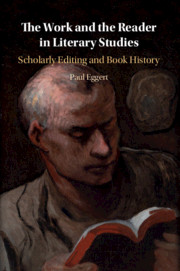17 results
9 - The Art of Criticism: Essay as Citation
- from Part I - Forming the British Essay
-
-
- Book:
- The Cambridge History of the British Essay
- Published online:
- 31 October 2024
- Print publication:
- 04 July 2024, pp 120-134
-
- Chapter
- Export citation
Chapter 19 - Critical and Literary Theory
- from Part III - Cultural Transfers
-
-
- Book:
- Europe in British Literature and Culture
- Published online:
- 06 June 2024
- Print publication:
- 13 June 2024, pp 306-321
-
- Chapter
- Export citation
Chapter 1 - Introduction
-
-
- Book:
- The Cambridge Critical Guide to Latin Literature
- Published online:
- 04 January 2024
- Print publication:
- 18 January 2024, pp 1-42
-
- Chapter
- Export citation
Chapter 2 - How We Read Comics Now
-
- Book:
- The Rise of the Graphic Novel
- Published online:
- 06 July 2023
- Print publication:
- 20 July 2023, pp 26-61
-
- Chapter
- Export citation
15 - Ideology in Critical Crime Fiction
-
-
- Book:
- The Linguistics of Crime
- Published online:
- 05 January 2023
- Print publication:
- 05 January 2023, pp 330-331
-
- Chapter
- Export citation
4 - Ideology in Mainstream Crime Fiction
-
-
- Book:
- The Linguistics of Crime
- Published online:
- 05 January 2023
- Print publication:
- 05 January 2023, pp 57-87
-
- Chapter
- Export citation
Chapter Fifteen - Close Reading (and) Textual Bibliography
- from Part V - New Directions
-
-
- Book:
- Margaret Cavendish
- Published online:
- 28 April 2022
- Print publication:
- 12 May 2022, pp 233-247
-
- Chapter
- Export citation
Afterword: &
-
- Book:
- Nineteenth-Century American Literature and the Discourse of Natural History
- Published online:
- 16 November 2021
- Print publication:
- 18 November 2021, pp 183-190
-
- Chapter
- Export citation
3 - Writing about Poetry
-
- Book:
- The Cambridge Guide to Reading Poetry
- Published online:
- 04 November 2021
- Print publication:
- 18 November 2021, pp 218-232
-
- Chapter
- Export citation

The Cambridge Companion to Prose
-
- Published online:
- 05 November 2021
- Print publication:
- 18 November 2021
“The Quickening Virtue”: Reiterating the Work of the Literary Text
-
- Journal:
- Cambridge Journal of Postcolonial Literary Inquiry / Volume 8 / Issue 3 / September 2021
- Published online by Cambridge University Press:
- 11 October 2021, pp. 345-359
-
- Article
- Export citation
Chapter 2 - The Bible, the Novel, and the Veneration of Culture
- from Part I - Rethinking the Secular at the Origins of the English Novel
-
- Book:
- Rethinking the Secular Origins of the Novel
- Published online:
- 16 March 2021
- Print publication:
- 25 March 2021, pp 37-64
-
- Chapter
- Export citation
Introduction
-
-
- Book:
- The New Modernist Studies
- Published online:
- 21 January 2021
- Print publication:
- 04 February 2021, pp 1-22
-
- Chapter
- Export citation
Close(d) Reading and the “Potential Space” of the Literature Classroom after Apartheid
-
- Journal:
- Cambridge Journal of Postcolonial Literary Inquiry / Volume 7 / Issue 3 / September 2020
- Published online by Cambridge University Press:
- 09 September 2020, pp. 274-285
-
- Article
- Export citation
Chapter 4 - Feelings under the Microscope: New Critical Affect
- from I - Origins
-
-
- Book:
- Affect and Literature
- Published online:
- 16 January 2020
- Print publication:
- 06 February 2020, pp 83-99
-
- Chapter
- Export citation
Chapter 7 - Book History and Literary Study
-
- Book:
- The Work and the Reader in Literary Studies
- Published online:
- 19 August 2019
- Print publication:
- 29 August 2019, pp 108-130
-
- Chapter
- Export citation

The Work and the Reader in Literary Studies
- Scholarly Editing and Book History
-
- Published online:
- 19 August 2019
- Print publication:
- 29 August 2019


